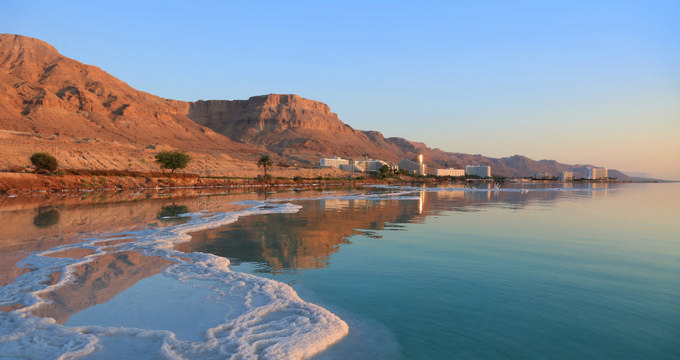Discover the extraordinary elevation of the Dead Sea, the Earth's lowest exposed point on land. Bordering Jordan and Israel, this large salt lake lies deep within the Jordan Rift Valley and features a one-of-a-kind geological and climatic environment. Its remarkable salinity, historical importance, and health benefits attract millions every year.
Table of Contents
Dead Sea Overview
- What is the Dead Sea?
- A salt lake situated between Israel and Jordan, known for its exceptional salinity and mineral-rich waters.
- Size and dimensions:
- Length: 31 miles (50 km), Width: 9.3 miles (15 km)
- Surface area: 234 sq mi (605 km²), Shoreline: 84 miles (135 km)
- Depth:
- Average depth: 653 feet (199 m)
- Main tributary:
- The Jordan River flows in from the north.
Elevation Basics
- Surface elevation:
- 1,412 feet (430.5 m) below sea level—the lowest land elevation on Earth.
- Depth-based elevation:
- The Dead Sea's deepest point reaches 2,388.5 feet (728 m) below sea level.
- Salinity:
- Salt content is 34.2%, making it one of the saltiest bodies of water globally.
- Why people float:
- Its dense, mineral-rich waters allow effortless floating on the surface.
- Historic significance:
- Used by King Herod and ancient civilizations for healing and skincare.
- Environmental concerns:
- Water levels are declining due to reduced inflows and industrial use.
Must-Know Elevation Facts
- What is elevation?
- Elevation is the height of a point relative to sea level.
- Global context:
- Most Earth locations lie above sea level; the Dead Sea is the deepest exposed land depression.
- Nearby low points:
- Neot HaKikar: 1,132 ft (345 m) below sea level
- Jericho (West Bank): 846 ft (258 m) below sea level
- Sea of Galilee: 702 ft (214 m) below sea level
- Tiberias: 679 ft (207 m) below sea level
- Other low points globally:
- Lake Assal, Djibouti: 502 ft (153 m) below sea level
- Baku, Azerbaijan: 92 ft (28 m) below sea level
- Badwater Basin, USA: 279 ft (85 m) below sea level
Climate and Conditions
- Climate impact of elevation:
- The Dead Sea’s low elevation contributes to year-round sunshine and dryness.
- Summer temperatures:
- Peak temperatures in July can reach 104°F (40°C), with lows around 85°F (30°C).
- Winter temperatures:
- In January, expect highs of 69°F (20°C) and lows of 55°F (13°C).
- Water temperature:
- The Dead Sea’s waters remain warm throughout winter, warmer than the air.
- Rainfall:
- Annual rainfall is minimal—just 1.65 inches (42 mm) over approximately 15 days.
- Humidity:
- Ranges between 20% and 40%, contributing to its dry desert environment.
Plan Your Trip


